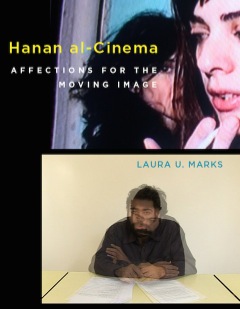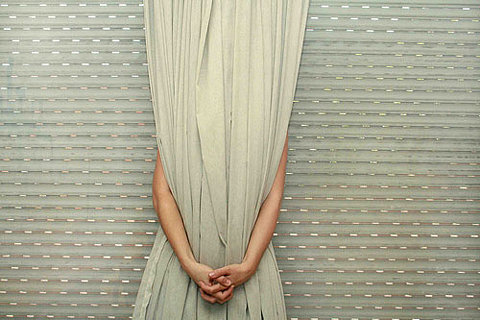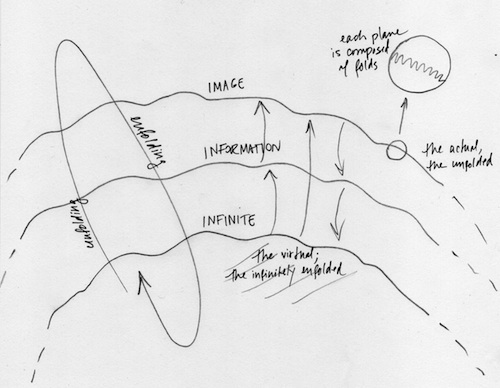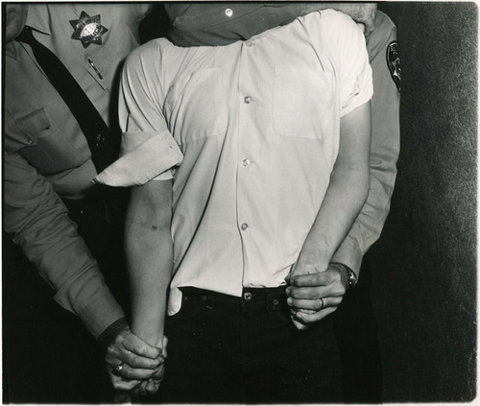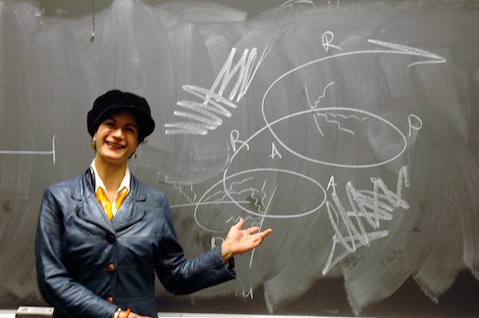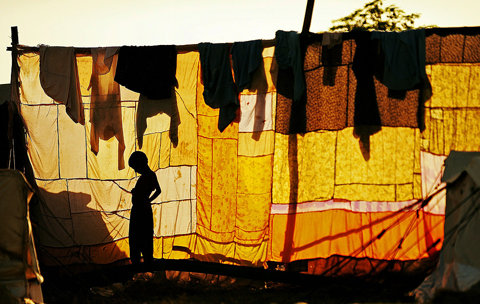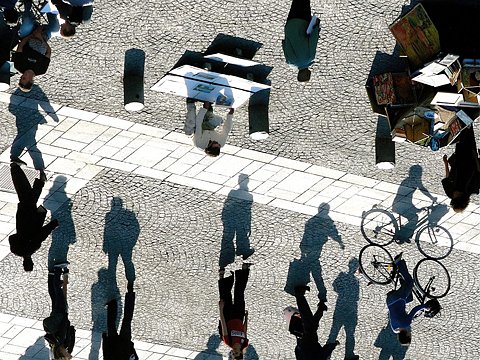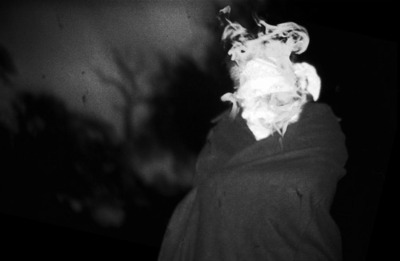Hanan al-Cinema, Affections for the Moving Image by Laura U. Marks (MIT Press, 2015)
Here is a remix of Laura’s stunning study of Arab cinema.
1. In information-based media and in the information era in general, the important invisibilities are databases, algorithms that manipulate them, and networks that facilitate the exercise of power, often government and corporate power.
2. In Western media… there is a hunger for explanations… of instrumentalising the work so it may serve as a means to an end.
3. Deleuze: Creating is not communication, but resisting… Art is what resists: it resists against death, servitude, infamy, shame…
4. (Deleuze and Guattari) a war machine: a force of instability and becoming that destabilizes the apparatus of the state.
5. Contradictions like these make folds in the commodified image-skin of global capitalism.
6. Instead we need to see private memory as a set of forces that acts only when it is mobilized. Thinking, Deleuze wrote in his interpretation of Foucault, constitutes cutting transverse lines across the field of power/knowledge.
7. Most people who make art struggle between the desire to be relevant and the wish to create.
8. The feathery breeze that brushes your neck when a political commitment becomes irreversible.
9. A secret repetition animates the statement.
10. We do not represent.
11. Foucault writes that the two registers, what can be said and what can be perceived, are mutually antagonistic.
12. Censorship draws attention to what it means to hide.
13. Akira Mizuta Lippit characterizes the shadow archive as what cannot be archived, and therefore survives when the archive is destroyed. We could also consider it the enfolded archive.
14. As Kassir points out, the nakba was a catastrophe not only because of what happened to Palestine but ‘because it signified to the Arabs – at least those in the Levant – that foreign rule, which seemed to be on its way out after World War II, was there to stay and that they were as helpless to confront it as they were at the end of the First World War.’
15. Homi Bhabha: “The narrative authority of the nation is split between the moments of the pedagogical, or how the nation is represented from on high, and the performative, or how it is recreated in daily practice.”
16. Gottfried Leibniz: all matter is one substance, whose smallest element is a fold…
17. The past reaches us or becomes actual to us through selective unfolding, in a relationship between experience, information, and image.
18. While experience is infinite, the vast majority of experience lies latent. Few images ever arise from it. Nevertheless anyone can unfold any aspect of experience to become a public image.
19. The cut is where ideology enters.
20. Power consists in the ability to exert some sort of regulatory, instrumental, or ideological force in terms of what aspects of experience are deemed important.
21. Information is the new spectacle.
22. There are two kinds of image: images that directly unfolds experience and images that are manifestations of information or capital. The second kind of image is the visible manifestation of information and capital – it is the skin of information.
23. Much art is concerned with the nature of en/unfolding rather than with producing images; these artworks (and other things) thus are not so much representational as performative.
24. Eroticism is an attitude of vulnerability, of opening oneself to the unknown at the same time that one attempts to know the other. The act of unfolding the other affects the body of the actor; in Spinozan terms, it combines the powers of the two bodies in ways that may increase their powers or may act as poison.
25. When Foucault sought traces of ‘infamous men’ in the archive, his approach was guided by ‘my taste, my pleasure, an emotion, laughter, surprise, a certain dread, or some other feeling whose intensity I might have trouble justifying.’
26. These uploaded photos and videos call out to the unknown viewer to complete the desiring and admiring look that the performers direct toward themselves.
27. Unfolding gives rise to affect. I have noticed two kinds. One occurs when a film or artwork actualizes a forgotten event or concealed knowledge. A certain tensile strength indexes the strength of this thing’s resistance to unfolding. When it unfolds and becomes actualized, you may very well feel a physical release in your body that corresponds to the release of the unfolded element.
28. A different kind of affect occurs when you participate in a new connection that brings things into contact, makes a new fold. Thinking is making folds, as Deleuze wrote.
29. Eroticism is the attraction not of the known but of the unknown.
30. Art makes the body vulnerable to forces that it has protected itself from, as Elizabeth Grosz argues; it can do so only because it is framed.
31. They retain the deeply Islamic spirit of cherishing things too delicate to expose, until they are ready to be alive.
32. The body without organs must be constructed with great care. As (Deleuze and Guattari) they write: Dismantling the organism has never meant killing yourself, but rather opening the body to connections that presuppose an entire assemblage, circuits, conjunctions, levels and thresholds, passages and distributions of intensity, and territories and deterritorializations measured with the craft of the surveyer.
33. The body can sustain only so much transformation at a time. In Spinozan fashion, Braidotti proposes that the goal of life is to encourage nondestructive flows and transformations that will give rise to joyful or positive affects and the transcendence of reactive affects. This approach informs an assiduous care to keep bodily energies enfolded in order to allow them to develop strength.
34. A number of artists and filmmakers seek to protect Arab bodies specifically from their overexposure in Western news media.
35. Trinh T. Minh-ha: To speak not about, but nearby.
36. Happiness arises from the feeling of a capacity to change one’s circumstances, sadness from a feeling of incapacity and a lack of agency. Spinoza argues that happiness comes from having adequate ideas about what causes pleasure and pain to the body.
37. Spinoza’s invitation to understand life as a constant interaction between bodies that can augment or diminish our own body’s powers translates well to encounters with moving images.
38. How can we tell whether the encounter with another body enlarges our body’s capacities or threatens them? How can we know that a movie is good for us in the Spinozist sense that it expands our capacities to affect and be affected, that is, to experience our relatedness to the world (the power to be affected).
39. All the ways that laughter can feel on your face.
40. In self-organized systems, the individual does not precede the encounter but is individuated by the encounter.
41. We understand that for this artist, images do not arise without a struggle, and the images that do exist are likely to support the claims of the powerful.
42. The word algorithm itself is a Latinization of the name of the ninth-century mathematician Al-Khwarizmi, who gave the word algebra.
43. These days algorithmic structures are associated not with pleasing mosque designs but with systems for surveillance and control.
44. If piracy is making illegal copies for profit, bootlegging is making illegal copies for love.
45. In countries where homosexuality is the norm, but homosexuality is illegal.
46. Textiles, the oldest of matrix-based media, are the great-great-grandmothers of computer-based art. They offer a genealogy for compression in digital and other quantified media.
47. They produce oceans of chaos and emergent patterns in which every pixel shouts its freedom.
48. By engaging with an object in a haptic way, I come to the surface of myself… losing myself in the intensified relation with an other that cannot be known.
49. Signs are realized only in relation; they have to move, to circulate… Images constitute a connective tissue between their perceivers and their source.
50. its etymology of kinema, movement
51. The linear story is a fairly recent invention, arriving with the eighteenth-century European novel and dominating Western culture, and then world culture, for a couple of hundred years. Nonlinear narratives are much older. Religious books, for example, are databases to be retrieved selectively and interpreted, generating additional databases of commentary. Storytelling is interactive, each story linked to a database of more stories, as Grahame Weinbren writes. These stories loop, staring over with variations; they embed other stories; they respond to the demands of users. Storytellers themselves are databases, performatively retrieving and connecting stories in response to the desires of their listeners.
52. Networks organize people’s subjectivity on the surface, not in depth, for it is our surfaces that interact and interface with others… Networks dissolve subjectivity at the same time that they reinforce connectivity. But as we know, the networked media of the internet became instruments of surveillance and control with dismaying rapidity. The visionary ideas of the Internet pioneers were quickly colonized for profit and military motives. Networks are a means of surveillance and control as much as, or more than, nonhierarchical media for grassroots organization. Far from liberating people, networks ‘create the conditions for a new mode of sovereignty’ as Alexander Galloway and Eugene Thacker point out.
53. Surveillance media rely not on images as such but on the capacity to extract information from images.
54. (In Rear Window) Hitchcock anticipated the translation of social relations into information.
55. Nietzsche: Resentment is the action of those who are not free.
56. Artaud: “thinking tears through the whole thickness of our vitality, the endless intertwining of our sensations and memories, everything that is recorded in the body.”
57. As Elena del Rio explains, at the molar level cinema deals with bodies as a whole, in a way that can support identity politics and struggles for representation… Meanwhile the molecular level deals with energies that are not yet captured by discourses of identity…. They operate a little below the radar of discourse and identity because that’s where they can be most creative.
58. All her defenses have fallen; she has the complete relaxation of the utterly defeated… Defeated at the molar level, energies are gathering at the molecular level.
59. Achieving adequate ideas that will increase your capacity to live.
60. Archive
I use the word archival for what can just as well be called found footage or appropriated images, in order to benefit from the theoretical heft of the archive. Carolyn Steedman offers a working definition of an archive: a name for the many places in which the past (which does not now exist, but which once did actually happen, which cannot be retrieved, but which may be represented) has deposited some traces and fragments, usually in written form.” Recently archivists have begun to accept that the time between history (what archives keep) and social memory (what users want from the archive) is blurred. Few believe any longer that archives are neutral, and more attention is paid to the messy and fragmentary process by which archives come together…
And what do artists find in the archive? It is not an image that is found. It’s not memory itself. It’s a flash from the past that changes the present – a fossil, a combustion. A found image may stimulate the act of remembering, generating ‘a cloud of virtualities’ some of which actualize in the moment of viewing. I like to think, after Henri Bergson and Alfred North Whitehead, that the past exists and is continuously preserved. Most of the past is not present to anyone, but some of it can be made present… Paula Amad argues that film can store the intimate and unclassifiable for future ‘referral and resuscitation’, especially when the filmmaker has resisted the Griersonian imperative to transmit a message and instead maintained an open and curious attitude toward the everyday…
Therefore, most of the movies this chapter studies are meta-cinematic or meta-mediumistic, that is, they draw attention to the conditions in which moving-image media are made, shown, and stored. They refer to the condition of the original, the cost of attaining it, the damage and alterations it endured along the way. Each archival fragment drags all this material, cultural, and political baggage after it, as a lady’s long train sweeps up and carries along debris as she passes. But little glimmers of the past that escaped the way it was captured nevertheless remain, perceptible to us now if we can find a way to see or hear them.
Sometimes, in the most straightforward use of archival artifacts, filmmakers use the content of archival films and photos simply as confirmation of past events. Sometimes the materiality of the archival object is more telling than the content. Sometimes archival images arouse drams, half-felt longings; they becomes ‘lures to feeling,’ in Whitehead’s term, and to thought. The most interesting archival films release perceptibles from their past configurations in order to draw them out as singularities, link them to other things, invent series, and intensify them by connecting to present experience in the affective response of viewers. (I use the term perceptibles, an expansion of Michel Foucault’s term visibilities, to indicate all that can be perceived by the senses, including those other than sight and hearing.) They don’t give proofs but release new possibilities for thinking: these acts are the topic of the second part of this chapter. To be in the archive, Steedman writes, is to occupy an intermediate space, neither inside an individual nor outside in a world of shared reality. This intermediate living occupies ‘a potential space, negating the idea of space and separation.’ Being in the archive is neither personal nor yet social; the playful work done there creates history or, I would say, unfolds history, by teasing new finds out of what seemed like nothing.
Engaging with the archive is a flirtation, an erotic practice, a romance.
Enfolding-unfolding aesthetics, my hybrid of Foucault, Deleuze, and Isma’ili Shi’ite thought, thinks of the past as ‘enfolded’ rather than lost. I adapt this concept from Deleuze’s thesis on Leibniz. Every element of matter – and every soul that matter protects – exists as a fold. Even the dead continue to exist as folds, as Deleuze remarks when he writes that the dead don’t disappear, they just fold up very small. In this way, we can think of the past as deeply enfolded, a virtuality that can be unfolded and pulled into actuality. The pat, I argue, reaches us or becomes actual to us through selective unfolding, in a relationship to the infinite, the information that filters the infinite or folds it in a certain way, and the image that result. The toughest folds protect the most important knowledge. Isma’ili thought argues that the most important secrets can be unfolded only by one with exclusive knowledge: the secrets contained in the esoteric suras of the Quran can be properly interpreted only by the imam.
An archive, in this understanding, is a textured surface, a collection of peaks of folds, some of which the researcher chooses to tug out and actualize while leaving others enfolded. The archival media artist unfolds the archive transversally, comparing the existing image to the filter through which it passed in order to get a sense of the unavailable original.
